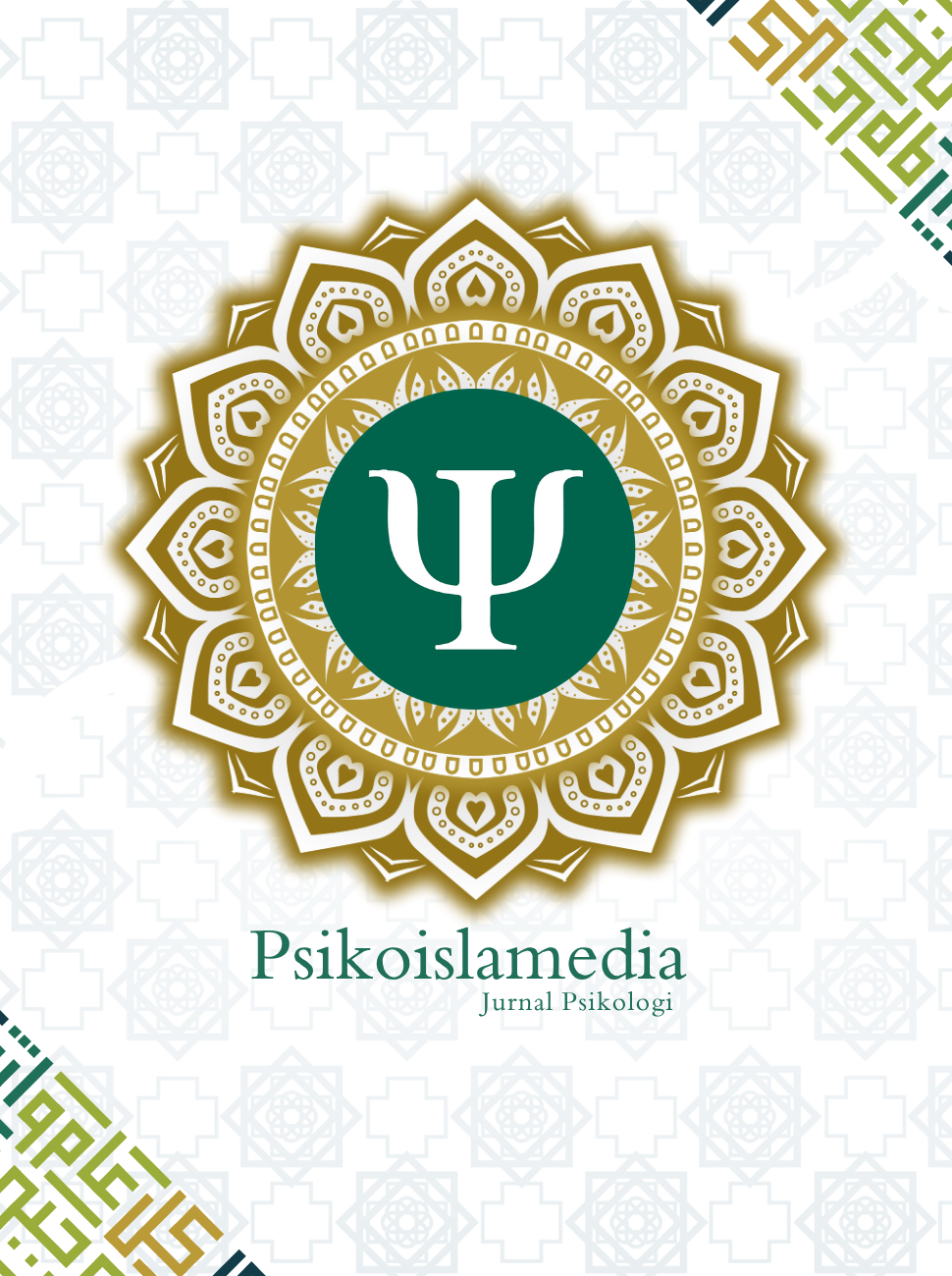DECISION-MAKING IN ADOLESCENTS AT RISK FOR NON-SUICIDAL SELF-INJURY (NSSI) BEHAVIOR
DOI:
https://doi.org/10.22373/psikoislamedia.v10i1.29077Keywords:
emotion regulation, decision making, father involvement, NSSIAbstract
Non-Suicide Self Injury (NSSI) or self-harm is being widely discussed and conducted by adolescents in Indonesia. This study was conducted on adolescents in Karawang using 3 measuring instruments, GDMS, DERS-18 and Father Involvement Scale. The purpose is to determine the dynamics of decision making in adolescents who have a tendency to commit NSSI. The population in this study was 116 adolescents age range 12-21 years who live in Karawang. The analysis used JASP by looking at path analysis both directly and indirectly. Decision making is divided into 5 types. The results is a direct influence of spontaneous decision making on NSSI. Showing that individuals who have a tendency to make decisions quickly and without thinking carefully are at higher risk of committing NSSI. Furthermore, emotional regulation plays an important role in mediating the influence of other decision making on NSSI. And also mediates the influence of father involvement on NSSI.References
American Psychiatric Association (2022). Diagnostic and Statistical Manual of Mental Disorders: 5th Text Revision. Washington: American Psychiatric Association Publishing
Auliya, F., Pranoto, Y. K., & Sunarso, A. (2020). Kecerdasan Moral Anak Usia Dini. Pekalongan: PT. Nasya Expanding Management.
Barida, M., & Prasetiawan, H. (2018). Urgensi Pengembangan Model Konseling Kelompok Teknik Self Management Untuk Meningkatkan Kecerdasan Moral Siswa SMP. Jurnal Fokus Konseling, 4(1), 27-36.
Baiocco, R.; Laghi, F. & D’Alessio, M.D. (2009). Decision-Making Style Among Adolescents: Relationship with Sensation Seeking and Locus of Control. Journal of Adolescence 32. 963 – 976
Crespo, A.A. dkk (2019). Spanish Validation of General Decision-Making Styles Scale: Sex Invariance, Sex Differences and Relationships with Personality and Coping Styles. Judgment and Decision Making. Vol 14 No. 6. 739 – 751
Dewi, A., & Fithria. (2017). Teman Sebaya dengan Perkembangan Moral Remaja. Jurnal Ilmiah Mahasiswa Fakultas Keperawatan, 2(4), 1-6.
Dewi, N; Putri, D.R. & Trikusumaadi, S.K. (2023). Pengambilan Keputusan Mahasiswa Ditinjau dari Kecerdasan Emosi dan Perkembangan Moral. Jurnal Talenta Psikologi Volume XII Nomor 2
Gong Y, Yan J, Deng Y, Bao C, Yi Q, Liu J, Zhang Z. Examining impulsivity and risky decision making among school youth in balloon analogue risk task. Transl Pediatr 2022;11(1):127-137. doi: 10.21037/tp-21-594
Happywidinata, R. & Abdurrohim. (2019). Hubungan antara Kematangan Emosi dengan Pengambilan Keputusan Pada Aktivis di Unissula. Prosiding Konferensi Ilmiah Mahasiswa Unisulla (KIMU) 2
Haris, I. (2012). Determinant Factors of Decision Making Procerss in Higher Education Institution. Global Journal of Management and Business Research Vol 12 (18). 33 – 40
Kamal, M.M.; Bideli, A.Z.; Themistocleous, M. & Morabito, V. (2015). Invertigating Factors Influencing Decision Makers while Adopting Integration Technologies. Information and Mangement 52 (2). 135 – 150
Lamb, M. E., Pleck, J. H., Charnov, E. L., & Levine, J. A. (1985). Paternal behavior in humans. American Zoologist, 25(3), 883-894.
Lamb, M. E. (2000). The history of research on father involvement: an overview. Marriage & Family Review, 29:2-3, 23-42, DOI: 10.1300/J002v29n02_03.
Lennick, D., & Kiel, F. (2011). Moral Intelligence 2.0 Enhancing Business Performance. Upper Saddle River: Pearson Education.
Loureiro, R.J. (2020). Decision Making in Adolescents: A Multifaceted Construct. J. Hum Growth Dev. 30 (2). 160 – 163. DOI: https://doi.org/10.7322/jhgd.v30.10362
Mardia, E.; Dimala, C.P. & Aisha, D. (2023). Kematangan Emosi dengan Perilaku Ujaran Kebencian pada Remaja Akhir. Psikoborneo, Jurnal Ilmiah Psikologi. Vol 11 (2). 254 – 260
McEvoy, D. dkk (2023). Risk and Protective Factors for Self-Harm in Adolescents and Young Adults: An Umbrella Review of Systematic Reviews. Journal of Psychiatric Research 168. 353 – 380
Miller, D.C. & Byrnes, J.P. (2001). Adolescents’s Decision Makign in Social Situations: A Self Regulation Perspective. Applied Development Psychology. 22. 237 – 256
Noguiera, M.J; Barros, L. & Sequeira, C. (2017). Psychometric Properties of the Psychological Vulnerabiltiy Scale in Higher Education Students. Journal of the American Psychiatric Nurses Association. 1 – 8.
Parikh, R. H. (2016). A Study of Various Dimensions of Emotional Maturity of Intact and Broken Home Children
Pradini, A. S., & Cahyanti, I. Y. (2022). Gambaran Kematangan Emosi pada Anak Remaja Akhir dari Keluarga Bercerai (Hidup)
Rachmaniya, A. S., & Rahayu, S. A. (2019). Hubungan antara Kematangan Emosi dengan Psikosomatis pada Remaja yang Tinggal di Pondok Pesantren. Jurnal Bimbingan dan Konseling Islam
Raviyoga, T. T., & Marheni, A. (2019). Hubungan Kematangan Emosi dan Konformitas Teman Sebaya terhadap Agresivitas Remaja di SMAN 3 Denpasar. Jurnal Psikologi Udayana
Sovitriana, R., & Sianturi, H. C. (2021). Kematangan Emosi dan Konformitas Teman Sebaya dengan Perilaku Agresif pada Remaja di Kelurahan X Kabupaten Bekasi
Santrock, J.W. 2011. Child Development 13th Edition. Mc.Graw-Hill Companies: New York
Sudaryono, Dr. (2019). Metodologi Penelitian: Kuantitatif, Kualitatif, dan Mix Method. Edisi Kedua. Depok: PT RajaGrafindo Persada
Vereyra, S. & Fitria, L. (2023). Hubungan Kematangan Emosi dalam Pengambilan Keputusan Karir Siswa. Jurnal of Research and Investigation in Education 1 (2). 48 – 52
Victor, S.E & Klonsky, E.D (2016). Validation of a brief version of the difficulties in emotion regulation scale (DERS-18) in five samples. Journal Psychopathol Behavior Assessment. Springer
Walgito, B. (2010). Bimbingan dan Konseling Perkawinan (3 ed.). Yogyakarta: ANDI
Widyawati, R.A. & Kurniawan, A. (2021). Pengaruh Paparan Media Sosial terhadap Perilaku Self-Harm pada Pengguna Media Sosial Emerging Adulthood. Buletin Riset Psikologi dan Kesehatan Mental. Vol 1 (1). 120 - 128
Downloads
Published
Issue
Section
License
Authors who publish in this Journal agree to the following terms:
- Authors retain copyright and grant the journal right of first publication with the work simultaneously licensed under Attribution-ShareAlike 4.0 International (CC BY-SA 4.0) allows others to share the work with an acknowledgment of the work's authorship and initial publication in this journal.
- Authors are able to enter into separate, additional contractual arrangements for the non-exclusive distribution of the journal's published version of the work (e.g., post it to an institutional repository or publish it in a book), with an acknowledgment of its initial publication in this journal.
- Authors are permitted and encouraged to post their work online (e.g., in institutional repositories or on their website) prior to and during the submission process, as it can lead to productive exchanges, as well as earlier and greater citation of published work. (See The Effect of Open Acces)














